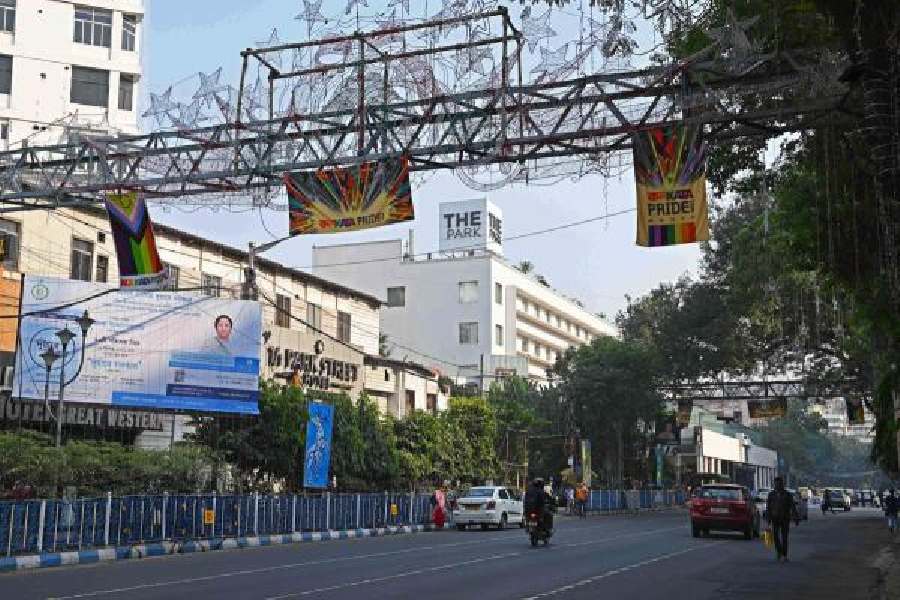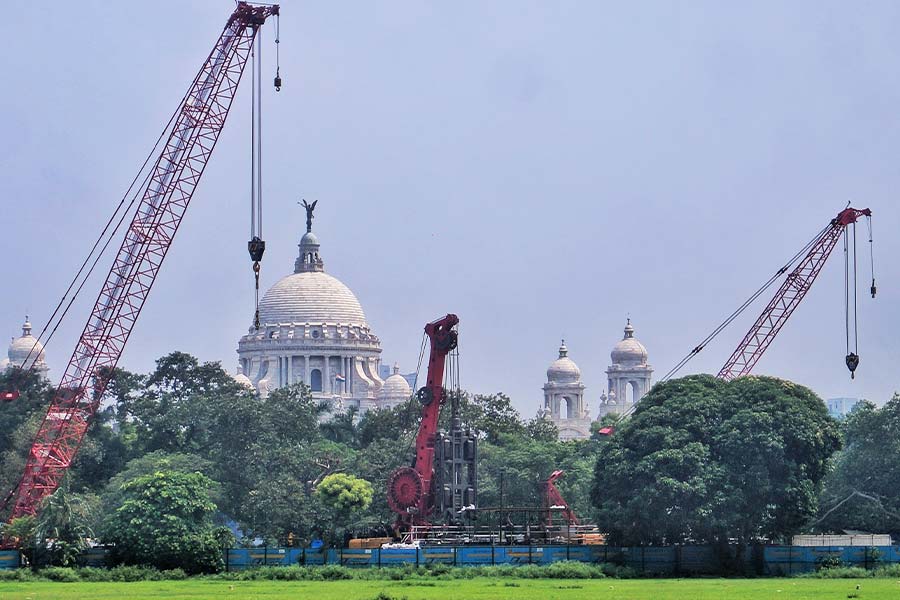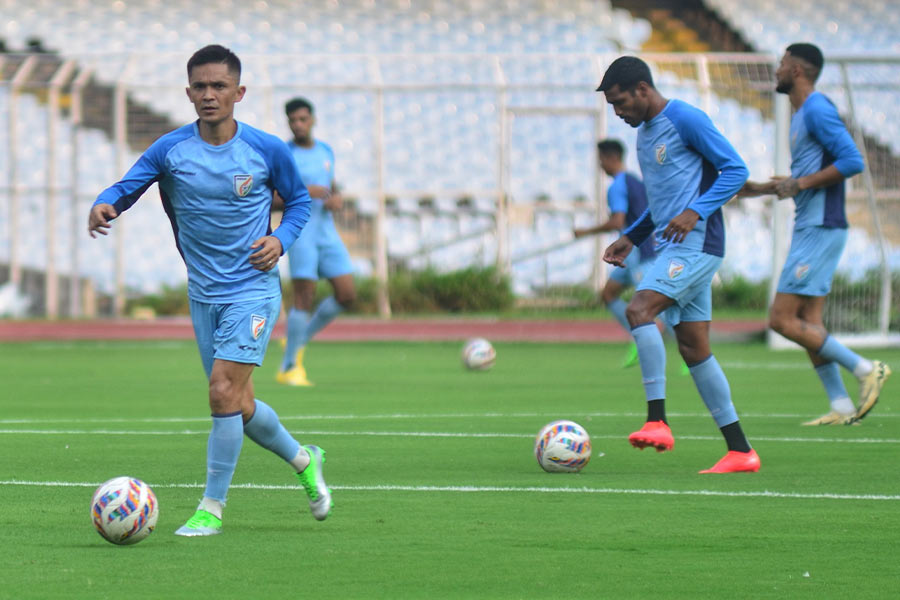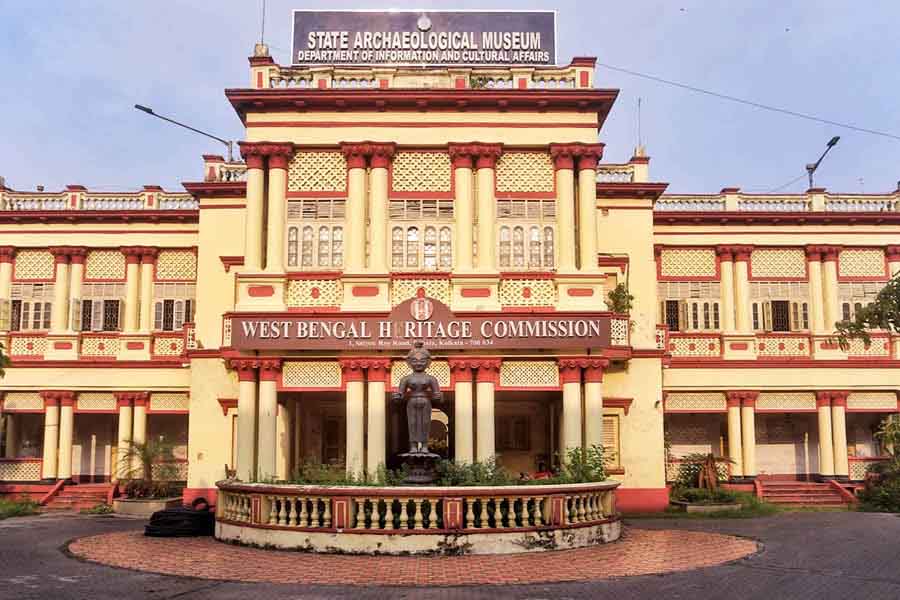Sometimes the city has reason to be proud of itself.
If you look closely at the gantries on Park Street, the overhead structures that support the illuminations that are now customary during Kali Puja, Diwali and then Christmas, you will see suspended from some of them brightly painted banners, carrying the words Kolkata Pride.
The banners are announcing the Kolkata Rainbow Pride Walk, a major, celebratory event for the queer community in the city and outside, to be held on Sunday this year.
Last year, thousands participated in the walk, turning Park Street into an explosion of colours.
The community is cheering the way the banners have become a part of the Park Street decorations. This is an act of affirmation for the community: it is not only an official stamp but also an invitation to the party that is Park Street in December.
The banners can be put up like this, the walk organisers feel, only because the city is Kolkata.
One late evening last week, a group of young volunteers started work and stayed up till the early hours — their enthusiasm visible and audible — to put up the banners, ending very close to the Park Street police station. Police officials guided them.
“It is difficult to imagine this in any other Indian city,” said fashion designer Navonil Das, or Nil, co-initiator, Kolkata Pride dot org, which is a participant in the rainbow walk.
“We should be aware of the many things we take for granted in Kolkata,” Nil adds.
The political climate in the city — and the state — contributes towards it.
The banners were hung for the first time in the run-up to the rainbow walk. The city has been responsible for the way the walk itself has turned out.
“From last year, it was decided that it would not be held under a single banner. All participating organisations could bring their banners,” said another co-initiator of Kolkata Pride dot org, Anindya Hajra, a transgender rights advocate.
The intention was also not to let the city trample on the idea of Pride, which is to make visible the many different kinds of people who find themselves outside normative, heterosexual society. They do not all live in the city, or come from one religion, or speak one language, or dress in one way, and to ask them to march under a single banner would be to obliterate difference, which contradicts the idea of Pride, said Hajra.
The “urban aesthetic”, especially in the case of a Pride march with its emphasis on fashion as a political statement, can be overwhelming, and banners from the districts can be seen as not “aesthetic enough”.
“But the queer-trans fight for justice and liberation was meant to create a space that cannot be internally regulated,” said Hajra.
Many small organisations cannot afford visibility because they lack funds, resources or the right location. “About 15,000 people from the city and from the small towns and districts joined the march last year,” Hajra adds.
But that does not mean that the walk as it is now is the only way to do it, insists Hajra. “It is what it is. But there were walks before and there will be walks later,” she said.
Many remember, with pride and a certain wistfulness, the Friendship Walk that was held in 1999 in the city on a monsoon day to mark the 40th anniversary of the Stonewall riots. Only 15 turned up on the day, which included Pawan Dhall, Aditya Mohnot and Niloy Basu from the city, and Ashok Row Kavi, the founder of Bombay Dost. Wearing bright yellow t-shirts, the 15 had braved rain and curiosity and incomprehension to march on, and then split into two different groups to talk to NGOs and organisations in the city.
It was a moment of significance. The queer movement has become so large and the rainbow walks so huge, buoyed considerably by the contributions of the early activism years.
The 1999 march was the first Pride march held in the country, though the word “Pride” had yet to catch on. Kolkata hosted it.
The Pride march now has become a high point for the queer community — “yet, not the only one; the community does not stop living before or after the event,” Hajra smiles — but with it other events are being held in Kolkata.
An arts festival, Ko:QAM, the Kolkata Queer Arts Month, a Kolkata Pride dot org initiative, is being held from December 8 to January 3, at two galleries in the city, Experimenter Hindustan Road and Kolkata Centre for Creativity (KCC) at Anandapur, off EM Bypass. It has got generous sponsors from the city.
The show is exhibiting a host of artists, whose practices are unapologetic, bold and cannot be categorised, in any “straight” way at least, and gender is not the only lens here.
“A large part of me agreeing to curate the first edition of Ko:QAM was the city,” said fashion designer Kallol Datta, curator, Ko:QAM.
“Kolkata has allowed Ko:QAM to be assertive in its approach to the programming — multiple sites, a stellar list of exhibiting artists…,” writes Datta in the exhibition catalogue.
“There was a sense of urgency to do this, given the way the politics of the country, and the world, is going,” he said.
“There is something in the way the city imagines the other,” said Hajra. Or maybe does not.
“Kolkata, I think, is a kinder city,” she said. Relatively free of the burden of being a global smart city, it may be shabby, lazy and poor, but is also comforting, and not only for the queer. You can have a meal for Rs 30 here still.
The Pride banners last year were not taken off Park Street in a hurry, Hajra said.
But that could be the city’s unconcern, too, which is reflected clearly in the piling up of telephone wires mid-air everywhere.
Whatever it was, the banners stayed on.






